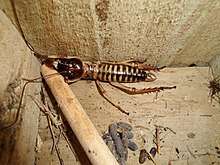Hemideina trewicki
The Hawkes Bay tree weta, Hemideina trewicki, is a large arboreal long-horned cricket in the order Orthoptera. The species is endemic to New Zealand and restricted to the Hawke's Bay region of North Island[1]
| Hemideina trewicki | |
|---|---|
 | |
| Hemideina trewicki (male) | |
| Scientific classification | |
| Kingdom: | |
| Phylum: | |
| Class: | |
| Order: | |
| Suborder: | |
| Family: | |
| Genus: | |
| Species: | H. trewicki |
| Binomial name | |
| Hemideina trewicki Morgan-Richards 1995 | |
Hemideina trewicki is a cryptic species: it looks like the Wellington tree weta, H. crassidens, but has a different number of chromosomes[1][2]. All tree weta (genus Hemideina) are nocturnal flightless herbivores. During the day they hide from predators in hollow branches and crevices. At night they search in trees for leaves, flowers and fruits to eat.
Distribution and Identification
Hemideina trewicki is common in forests and suburban gardens over most of the Hawke's Bay region. Within this range it overlaps with the Auckland tree weta H. thoracica[3]. The two species can be found sharing daytime refuge holes but hybridisation is limited to rare first generation hybrids[4]. Hemideina trewicki has black and yellow bands on its abdominal tergites (as seen in the Wellington tree weta H. crassidens) but has a pale pronotum with black marks as seen in H. thoracica. However, H. thoracica lacks the abdominal bands, and is more uniform body colour. All tree weta have long antenna, spines on their hind legs and adults can bite. The number of prolateral spines on each hind tibea can be used to distinguish the Hawke's Bay tree weta from the Auckland tree weta: Hemideina trewicki has 8 spines and H. thoracica has 6 (or sometimes 7) spines on each hind tibea [5].
Life Cycle & Mating
Tree weta are hemimetabolous insects, meaning they hatch from eggs as small versions of adults. Eggs are laid in the soil and hatch after about 8 months without parental care. Over about 12 months nymphs grow and molt nine times before reaching full size (8-12 grams) and sexual maturity. Hemideina trewick are smaller than the sympatric H. thoracica and reach maturity earlier in the summer[6]. During the late summer and autumn adult female tree weta shelter together in the same tree cavities[7]. Male weta use chemical cues to find other adult weta[8] and fight for access to harems.

References
- Morgan-Richards, M (1995). "A new species of tree weta from the North Island of New Zealand (Hemideina: Stenopematidae: Orthoptera)". New Zealand Entomologist. 18: 15–23. doi:10.1080/00779962.1995.9721996.
- Mckean, N. E.; Trewick, S. A.; Morgan-Richards, M. (3 April 2015). "Comparative cytogenetics of North Island tree wētā in sympatry". New Zealand Journal of Zoology. 42 (2): 73–84. doi:10.1080/03014223.2015.1032984. ISSN 0301-4223.
- Trewick, S (1995). "On the distribution of tree weta in the North Island, New Zealand". Journal of the Royal Society of New Zealand. 25 (4): 485–493. doi:10.1080/03014223.1995.9517498.
- Mckean, Natasha E.; Trewick, Steven A.; Morgan‐Richards, Mary (2016). "Little or no gene flow despite F1 hybrids at two interspecific contact zones". Ecology and Evolution. 6 (8): 2390–2404. doi:10.1002/ece3.1942. ISSN 2045-7758. PMC 4783458. PMID 27066230.
- Mckean, Natasha E.; Trewick, Steven A.; Morgan‐Richards, Mary (2016). "Little or no gene flow despite F1 hybrids at two interspecific contact zones". Ecology and Evolution. 6 (8): 2390–2404. doi:10.1002/ece3.1942. ISSN 2045-7758. PMC 4783458. PMID 27066230.
- Mckean, Natasha E.; Trewick, Steven A.; Morgan-Richards, Mary (2016). "Little or no gene flow despite F 1 hybrids at two interspecific contact zones". Ecology and Evolution. 6 (8): 2390–2404. doi:10.1002/ece3.1942. PMC 4783458. PMID 27066230.
- Wehi, P (2013). "Sex- and season-dependent behaviour in a flightless insect, the Auckland tree weta (Hemideina thoracica)". New Zealand Journal of Ecology. 37: 75–83.
- Wehi, Priscilla M.; Monks, Adrian; Morgan-Richards, Mary (2017). Tregenza, T. (ed.). "Male tree weta are attracted to cuticular scent cues but do not discriminate according to sex or among two closely related species". Ethology. 123 (11): 825–834. doi:10.1111/eth.12652.